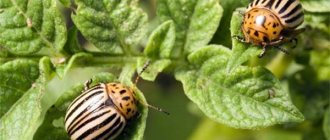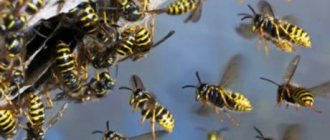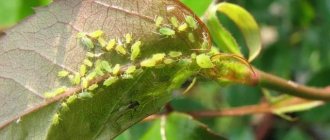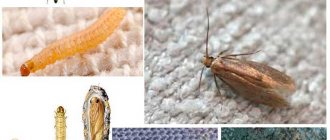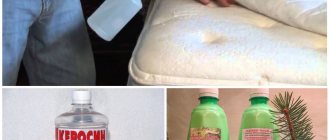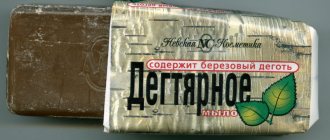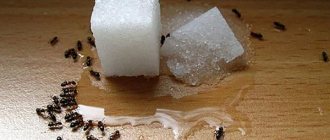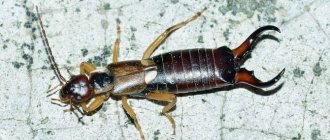Colorado potato beetle: features
The striped beetle quickly adapts to any remedy that is used against it. In no case should you ignore them; they are so voracious that they can destroy the entire harvest, and they also multiply and grow very quickly. One female can lay up to 1000 eggs over the summer. Colorados easily adapt to any conditions, burying themselves in the ground, they survive even the harshest winters. If there is a hungry year and nightshades are not planted, they go into hibernation, which can last up to three years. Therefore, every lucky person who has a plot of land or a house in the village is constantly worried about the question: how to get rid of the Colorado potato beetle?
Basic methods of controlling the Colorado potato beetle:
- chemical;
- agrotechnical;
- folk;
- biological.
Description
The Colorado potato beetle is an insect with an oval, convex, shiny yellow-orange body 8-12 mm long, up to 7 mm wide with five black stripes on each elytra. The beetle has black spots on the dorsum, the membranous wings are well developed - the beetles are able to make long flights.
The Colorado potato beetle larva, 15-16 cm long, has a black head and two rows of black spots on the sides. At first, the body color of the larvae is dark brown, but over time it becomes bright yellow or pinkish - when eating leaves, the larvae are able to digest all pigments except carotene, which, accumulating in the tissues, colors the bodies of the larvae in a carrot color.
Colorado potato beetles overwinter in the soil at a depth of 20 to 50 cm, and in the spring they come to the surface, feed on seedlings, mate and lay eggs on the underside of leaf blades. One female can lay from 5 to 80 eggs per day, and from 300 to 1000 eggs per season. The larvae of the first instar feed on the pulp of the leaves from the underside, the larvae of the second instar destroy the entire blade, leaving only the midribs, and the larvae of the third and fourth instar spread, often moving to other plants.
- White American Butterfly: Fight
After 2-3 weeks, they burrow into the soil to a depth of 10 cm and pupate, and after 10-20 days they turn into an adult and come to the surface or, if late autumn has already arrived, enter diapause until spring.
The lifespan of Colorado potato beetles is one year, but some individuals can live two or even three years. If the beetles are in danger, they do not fly away, but fall to the ground, pretending to be dead.
Classification of drugs for the Colorado potato beetle
Remedies for the Colorado potato beetle can be classified according to several parameters:
- By specialization: narrow, aimed at combating a specific species: adult, eggs or larvae;
- wide or universal. Effectively affects all phases of the life cycle. They are more toxic than narrowly targeted drugs.
- mordants for treating tubers;
- By method of exposure: contact. The advantage of such drugs is that they do not accumulate either in the stems or in the fruits themselves, but remain on the surface and act directly on the beetles. That is, they do not have any effect on the harvest and do not contaminate potatoes with unnecessary chemicals. However, when watering or raining, it is quickly washed off with water, which is why treatment should be carried out several times a season. The Colorado potato beetle adapts very quickly to this type of product, which is why each season you should choose a more modern product;
- biological. Biological agents are the safest and are aimed at ensuring that after eating them, the beetles lose their appetite and die of hunger. They are harmless to humans and can be used for early potato varieties. The main disadvantage is that the processing must be repeated several times. Usually three times with a break a week is enough;
- systemic. The drugs are considered most effective in the fight against the Colorado potato beetle. Some of them, for example, Prestige and Masterpiece, are designed to treat tubers before planting, which allows you not to worry about the harvest all season. However, this method cannot be used for early potato varieties due to its high toxicity. These agents penetrate into the stems and tubers of the plant, making them poisonous to beetles.
- According to the active substance: avermictins are safe for humans, but can be dangerous for bees or other insects, obtained naturally or industrially from streptomycete fungi;
- pyrethrins - obtained from Aster plants, non-toxic to humans, but dangerous to bees. Ineffective at temperatures above 25 °C;
- phosphorus - when used regularly, they quickly lose their effectiveness due to the fact that the beetles get used to it; drugs of this class should be changed at least once a season;
- neonicotinoids – used in systemic drugs.
Landing protection
How to get rid of the Colorado potato beetle? The following can help with this issue:
- biological agents;
- chemical poisons;
- folk recipes;
- natural enemies of the Colorado potato beetle.
And now about each in more detail...
Biological agents
Biological preparations for protection against the Colorado potato beetle are good because they are absolutely safe for all warm-blooded animals and are not capable of harming nature. As a result, the agronomist receives an environmentally friendly product, after cultivation of which the air and soil remain just as clean. Among the biological agents it is worth highlighting the following:
- "Bitoxibacillin";
- "Fitoverm";
- "Agravertine".
When working with such tools, you must remember the following rules:
- a working solution should be prepared from the concentrate according to the instructions;
- the treatment is carried out 2-3 times, since despite the high effectiveness against adults and larvae, such preparations do not destroy eggs;
- the crop is sprayed in calm, dry weather in the afternoon so that the dew has time to dry; the air temperature should not be less than +18°C.
Chemical poisons
When considering ways to combat the Colorado potato beetle, it is impossible to ignore chemical agents. Such substances, as a rule, are toxic to humans and animals, and therefore, when using them, you should wear protective equipment for the skin of your hands, mucous membranes and respiratory organs and work strictly according to the instructions.
Important! It is strictly forbidden to allow the use of pesticides that do not come with clear instructions. At the same time, it should contain information about the exact dosage of the drug, the rules for its use, as well as precautions and recommendations for eliminating poisoning caused by this drug!
Among insecticides, the following deserve the attention of agronomists:
- "Aktara";
- "Confidor";
- "Bankol";
- "Regent";
- "Mospilan";
- "Sonnet";
- "Corado."
Chemical poisons from the Colorado potato beetle are used as follows:
- prepare the working solution according to the instructions, without exceeding the specified dosage. If this condition is violated, harmful substances will accumulate in the tubers and soil;
- the beds are treated using a balloon sprayer;
- spray the plantings in the cool morning or evening;
- To avoid resistance in the Colorado potato beetle, the insecticide must be alternated with chemicals of another class.
Important! Chemical insecticides should not be used on a hot day, as there is a high probability of poisoning from dangerous fumes!
Methods of combating using chemistry
Good protection against the Colorado potato beetle should be effective and at the same time harmless to humans and the environment. The best option for treating potato plantations against pests is the use of biological preparations. They are absolutely safe for the soil and only harm Colorado potato beetles. The active components of such compositions do not poison water, the atmosphere or young potato tubers.
There are many ways to combat the Colorado leaf beetle using chemicals. The best of them will be discussed later in the article.
Method No. 1
Potato plantations are sprayed with a solution of Bitoxibacillin. This is a drug for the Colorado potato beetle in the form of tablets, which is recommended to be used no more than 4 times during the summer. The best option is 2-3 treatments once every 10 days.
It is advisable to spray potatoes using Bitoxibacillin at a temperature of 18°C or higher. To prepare the solution, take 40-100 g of the drug and dissolve it in water (10 liters). The main destructive effect of the prepared product is on the larvae. Due to paralysis, they cannot eat and become lethargic. The bacterial spores of the poisonous drug penetrate into the intestines of the larvae and develop rapidly there. After a short time, they take on the appearance of a shell filled with spores of a chemical drug. Such larvae subsequently produce beetles with deformities that pose a danger to healthy individuals, causing an epidemic. Beetles emerging from larvae poisoned by bitoxybacillin lose their ability to reproduce.
Method number 2
The biological product Colorado will help destroy the potato leaf beetle. The destructive effect of this product is directed against potato pests. They treat green potato bushes 1-2 times with an interval of 5-7 days. The drug should be used when new generations of Colorado potato beetle larvae appear. A solution from Colorado is prepared in the following dosage: 130-160 g of the drug is dissolved in a bucket of water.
Method number 3
The insecticide Bicol will help remove new Colorado potato beetle larvae from potato tops. Spraying with its use is carried out 2-3 times, taking a break of 7-8 days. Bicol dosage for 1 bucket of clean water – 20 g.
Method number 4
Use of the drug Fitoverm, which belongs to a new generation of insecticides and has a bioactive effect. The active components of Fitoverm penetrate into the body of adult beetles and beetle larvae by contact. When they enter the intestines, paralysis of the insect occurs. This usually happens 8-10 hours after processing the potato plantations. Beetles and larvae do not receive the necessary nutrition and die within 3-6 days.
It should be noted that the components of Fitoverm do not help cope with pest egg laying. Therefore, repeated spraying will be required after the larvae hatch from the eggs. The treatment, according to the instructions for the drug, must be carried out in clear weather, when the dew has dried on the leaves of the plant. The air temperature should not be lower than 18°C.
Method number 5
Application of the insecticidal agent Agravertin. The principle of operation of Agravertin is the same as that of Fitoverm. The active components of the drug provoke the development of paralysis in adult beetles and larvae. Lack of nutrition leads to the death of insect pests. The only difference is that Agravertine can be sprayed at a reduced air temperature of 12°C.
Method number 6
The drug Boverin will help effectively fight potato leaf beetle larvae. It is diluted in a bucket of water in an amount of 100-200 g. To treat 100 sq.m. potato plantings, you will need about 4 liters of this solution. New generations of larvae should be destroyed with Boverin 2 times, after a period of 10-12 days.
Method number 7
Effective destruction of the Colorado potato beetle occurs using potent chemical compounds. On the market for insecticidal drugs, customers are offered a wide range of such drugs. These include:
- Aktara;
- Bankol;
- Sonnet;
- Corado;
- Senpai;
- Regent;
- Confidor;
- Mospilan.
Green potato tops should be treated with them in the morning or evening, before 10 or after 18 o'clock, when the weather outside is warm, clear and windless. There should be no dew on the plants. Working with chemicals requires protection on your hands, face and eyes. The clothes in which the spraying was carried out must be washed well, and the shoes must be washed.
Dilution of chemical preparations for the Colorado potato beetle is carried out in accordance with the manufacturer’s recommendations indicated in the instructions. The effectiveness of the treatment will not depend on an increase in the concentration of the product or its consumption per unit area. Such actions will cause the accumulation of toxic chemical components in the tubers of young potatoes. The preparations need to be changed periodically so that the beetle does not get used to them.
Aktara
An effective drug for the Colorado potato beetle, chosen by vegetable growers. Has an intestinal contact effect. After processing the plantings, the active ingredients penetrate into all above-ground parts of the plant in 1-3 days. When eaten, toxic substances enter the stomach, poisoning the body.
To obtain homogeneity, first dilute 1.2 ml of Aktara in 200 ml of water. Then the resulting composition is added to 10 liters of water and shaken well. The solution is sprayed evenly over the leaves. Per 100 sq. m. 5 liters of the drug is enough.
Aktara's solution is resistant to high temperatures and direct sunlight. When treating leaves, the protection period is 2-3 weeks, when spraying the soil - 1.5 months. It has excellent compatibility with other insecticides and growth stimulants. Cannot be used in conjunction with alkaline compounds.
Iskra Golden
One of the best poisons for the Colorado potato beetle, which has a systemic effect. Shows excellent performance in pest control. The main active ingredient is imidacloprid. Sold in ampoules of 5 ml, bottles of 10 ml and packs of 40 g.
After treatment, the active ingredients penetrate into the green parts of the plant. The duration of protection is about 25 days and is not washed off by rain or artificial irrigation. The death of larvae and beetles occurs 1-2 days after spraying.
Commander
The highly effective insecticide Komandor is presented as a soluble concentrate. Effective for controlling the Colorado potato beetle even with severely damaged bushes. The main active ingredient is imidiacloprid,
Initially, the ampoule (1 ml) is diluted in 1-2 liters of water, then the solution is brought to 5 liters with water. The treatment is carried out using a sprayer, the composition is evenly distributed over the foliage. 5 liters of product is enough to treat 100 square meters. m.
You can poison the Colorado potato beetle on potatoes in any weather. Commander is not addictive to insects and does not pose a danger to humans, animals and plants. It is allowed to carry out treatments at any stage of development of potato plantings.
Note! One treatment per season is enough. It is carried out no later than 3 weeks before harvest.
Corado
Another product based on imidiacloprid, which has a systemic effect. 1-1.5 hours after entering the insect’s body, it makes the insect’s feeding process impossible. After a few days, the pests die.
It has little resistance to moisture, so it is recommended to carry out processing in windless, dry weather. It is best to process plantings in the evening or in the morning. At least 4 hours must pass after spraying before the rain begins.
Sold in 10 ml bottles and 1 or 5 ml ampoules. 1 ml of Corado is diluted in 10 liters of water. This volume is enough to spray 100 square meters. m. Corado remedy is valid for a month.
Prestige
One of the best systemic remedies for the Colorado potato beetle. The main active components are imidiacloprid (protects against various insects) and pencicuron (prevents fungal diseases, in particular rhizoctorosis, late blight). The protection is valid for 1.5 months.
Used for pre-planting treatment of potato tubers (consumption per kilogram of potatoes requires 1 ml of product). The working composition is painted pink, after drying a thin film is formed. The potatoes are laid out on a tarpaulin, sprayed, then the tubers are turned over and processed on the other side.
Since the product penetrates the stem and leaves during plant growth, insects eat it along with the green mass and die. They do not have time to lay larvae. Belongs to the third class of danger.
Additionally, treatment with Prestige stimulates crop growth and enhances anti-stress endurance. After the expiration date, the product decomposes into components that do not pose a danger to the environment and humans.
Taboo
An effective systemic product for controlling various pests of garden crops, which is used to treat tubers before planting. The main active ingredient is imidiacloprid.
When dry, the sticky surfactants in the composition form a film on the surface of the tubers.
The second way to use the Tabu insecticide is to treat the soil in rows and holes with already decomposed potatoes. For spraying, before planting, dilute 8 ml of the drug in 1 liter of water. When spraying green mass, dilute 4 ml of product per 10 liters of water. The duration of action of the insecticide is approximately 1.5 m.
Note! If the tubers have sprouts, they can be easily damaged. Therefore, spraying of planting material is carried out directly in the holes.
Tanrek
An excellent poison for the Colorado potato beetle. The active ingredient (imidacloprid) causes paralysis followed by death of the insect. After treatment, the insecticide permeates all green parts of the plant and remains in them for a month.
The drug does not pose any danger to humans, beneficial insects and animals if safety rules are observed. Equally effective at different temperatures.
Regent
A modern effective remedy for the Colorado potato beetle, which kills on the spot. It has a fast, prolonged effect. The main active ingredient is fipronil, which belongs to the class of phenylpyrazoles. It works well at different temperatures, destroys the pest in various phases of development, even if it has developed immunity to other toxic substances.
The regent is sold in 0.5 g bags. The contents are diluted in 20 liters of water and distributed over the foliage of plants using a sprayer. 20 liters of product is enough to treat 200 square meters. m. landing. During the season, 2 treatments may be required. The protection period is 2-3 weeks after spraying.
Folk recipes
You can use folk remedies for the Colorado potato beetle. Such drugs are practically safe for humans, affordable and quick to prepare. Let's look at some of them:
- an effective solution is prepared based on birch tar - 100 g of tar must be mixed in 10 liters of water, and then sprayed on the plantings;
- Ash also shows high efficiency, two glasses of which should be boiled in a liter of water for a quarter of an hour, left for two days, after which 45 g of laundry soap should be added to the solution and used for spraying;
- Herbal decoctions and infusions will help fight the Colorado potato beetle; they can be prepared using onion peels, elecampane, horsetail, celandine, dandelion and wormwood - about 200 g per bucket of water.
Treatment with herbal decoctions is carried out in the morning or evening once every seven days. Three weeks before harvest, spraying is stopped.
Manual collection
Clutches of pest eggs are located on the lower part of the leaves. During this period, insects are vulnerable, so manual collection will help achieve a significant reduction in the number of insects. Farmers inspect the tops of plants immediately after seedlings appear. The yellow clumps are crushed, burned, or the torn plates are placed in jars with brine or kerosene.
Treatment with infusions and herbs
An emulsion of laundry soap and ash will help in the early stages, before the mass appearance of larvae. The block is crushed, dissolved in a bucket of water and 2 liters of wood raw materials are added. The product is left for a day, then the young potato greens are carefully processed.
An infusion of onion peels is used to combat not only Colorado potato beetles, but also other pests. A ten-liter pan is filled halfway with scales, pressed down with a weight, and poured with boiling water. After 3 days, the insecticide is filtered through cheesecloth and diluted with clean water in a ratio of 1:2. The above-ground parts are sprayed with the solution, and the remaining product is buried in the soil in the beds.
Wormwood is used to combat Colorado potato beetles and repel harmful insects. For 7 liters of hot water, take 200 g of fresh or dried plant, add a glass of crushed wood ash. Leave for 4 hours, strain and pour into a spray bottle. Spraying is carried out every 15 days, stopping procedures 3 weeks before harvest.
A decoction of celandine is a natural insecticide, a high concentration of which will help destroy parasites. Half a bucket of fresh plant is poured with cold liquid and boiled for 15 minutes. Take 500 ml of product per 10 liters of water and treat green plantings.
Colorado beetles do not like mixtures of fresh tomato and eggplant tops. To prepare the solution, take 1 kg of crushed grass, add a bucket of warm water and leave for 5 hours. Before use, strain and add detergent.
Tobacco infusion is also used against the Colorado potato beetle. A high concentration of nicotine can poison pests without the use of chemicals. To prepare the product, pour 500 g of crushed leaves or plant dust into a bucket of water and leave for 48 hours. The resulting liquid is filtered, diluted in a concentration of 1:1, and sprayed on potato plantings.
Tobacco is a poisonous plant. It is dangerous not only for insects, but also for warm-blooded animals.
The larvae of Colorado beetles do not like the infusion of hot pepper. Pour 100 g of crushed spice into 10 liters of moisture, boil for 2 hours and add any detergent. The medicine is used 4 days after preparation. Spraying is carried out every 2 weeks or after rain.
The smell of crushed garlic repels insects, so the plant is used to combat parasites. 200 g of raw materials (arrows, cloves, leaves) are placed in a bucket of water and left to infuse for a day. Before spraying, the emulsion is filtered; To improve adhesion, pour in 40 ml of liquid soap.
Traps and bait
It is important to protect large areas of potatoes from pests. Of the many ways to combat the Colorado potato beetle, gardeners prefer special trapping devices. A ditch with steep walls is dug along the perimeter of the beds, having the following parameters:
- width – 50 cm;
- depth – 30 cm;
- slope – 45 °C.
The bottom of the trap is lined with dark polyethylene, the material is pressed tightly against all surfaces, holes are made every 2 m. The soil from the pit is laid along the edges in the form of additional mounds. Due to the abundance of moisture, a fungus that is dangerous for parasites develops under the film.
The principle of operation of the device is that in the spring the Colorado potato beetle does not fly yet. The insect, weakened by hibernation, moves by crawling. Once in a ditch, the pest cannot get out. The parasite is left to starve or die from a destructive fungus. At the beginning of the growing season, the device neutralizes up to 75% of the livestock.
Spot baits are suitable for small vegetable gardens in the spring and fall after harvest. The tubers are soaked in chlorophos for 24 hours. A week before sprouting, cut potatoes are scattered around the area. Colorado beetles, exhausted by wintering, eat the poisoned tubers and die within a few hours.
Plastic containers are used to prepare simple traps. The top part of the bottles is cut off and filled with bait from potato slices pickled with urea or peeled. The infusion is prepared from 100 g of urea and 1 liter of water; ground red pepper is added for effectiveness. The structure is placed on the bed at soil level, and the caught insects are destroyed. One building is designed for 5 square meters. m plot.
Insecticidal plants
Special herbs will help protect potato plantings from massive infestation by parasites. Insects are repelled by the aroma of certain crops, so they do not colonize areas with insecticidal plants. For this purpose, plant between the beds:
- spices – dill, coriander, onion, borage;
- flowers – night violet, marigolds, nasturtium;
- medicinal species - calendula, tansy.
Beans, beans and horseradish are planted along the perimeter of the potato plot and in the inter-row spaces. Leaf beetles are repelled by white nymph and catnip. Plants will not save you from a large number of Colorado potato beetles, but will make their stay in the garden uncomfortable.
Some individuals are not afraid of natural insecticides; they will have to be collected manually or other measures must be used.
Dry methods
Dusting potato plantings will help not only repel, but also destroy voracious parasites. Gardeners use special mixtures that give an insecticidal effect. Birch wood ash is poisonous to Colorado potato beetles. When planting tubers, 100 g of the substance is placed in each hole, and after sprouting, sprinkle with greens. The procedure is carried out in the morning dew, material consumption per hundred square meters is 10 kg.
Corn flour, cement and gypsum, when exposed to a humid environment, increase in volume, destroying the parasite that eats them. When dusting foliage, the product enters the digestive system of insects. To improve the insecticidal effect, farmers mix the material with birch ash.
Colorado beetles cannot tolerate the smell of pine needles, so sawdust and wood chips are used to protect against invasion by scattering the raw materials between the rows. Even if the parasite does not die, it bypasses the beds with cultivated plants.
Who eats the Colorado potato beetle?
Ladybugs (cochinellas) and lacewings feed on the larvae of the striped leaf beetle. But there is no point in breeding lacewings in an area to kill beetles, because they will do more harm than good. Gardeners are encouraged to raise poultry, certain species of which not only rid the garden of adult beetles, but are also valued for their nutritious meat. This:
- regular chickens;
- turkeys;
- domestic guinea fowl;
- pheasants and partridges.
Summer residents accustom the chicks to unusual food in advance, and then walk the adults on the plots. It is important not to leave the bird unattended in order to protect the potato bushes from damage and not to treat the plantings with chemicals.
It is also useful to know which wildlife species are feeding on the Colorado potato beetle in your garden plots. These include starlings, crows, cuckoos and hoopoes.
Destruction of the Colorado potato beetle using safe means
The use of chemicals in the fight against the Colorado potato beetle is undoubtedly effective, but not everyone decides to use them.
Aggressive chemicals can harm health and the environment. Moreover, now organic products are held in high esteem and are chosen by people leading a healthy lifestyle. And when growing high-quality products, the use of artificial additives in any form is extremely undesirable. Potatoes, especially those pickled in tubers, despite all the safety certificates, cannot be considered a 100% organic product.
How to protect your crop and get rid of the Colorado potato beetle without chemicals? The most inexpensive and easiest way is manual collection. But, despite its apparent simplicity, the method is also the most labor-intensive. In one day it is impossible to collect all the pests at once, without forgetting about the larvae and laid eggs. Especially considering that the Colorado potato beetle moves very quickly from place to place, is carried on clothing and animal fur, and also reproduces very quickly. This method is suitable for those who do not have a large area allocated for potatoes. The leaves should be treated very carefully, since young larvae and eggs are on the underside of the leaf. After collection, the beetles are burned.
If a large area of land is allocated for potatoes, this method will not be very effective. The beetles will fly from place to place, lay new eggs, and a huge amount of work will simply be useless.
A popular folk way to protect potatoes is to plant a plant between the rows, the smell of which is extremely unpleasant for the Colorado potato beetle. Dill is most often used. It is unpretentious and does not require special care, but pests do not like such a neighborhood. Onion peel. Buried in holes or furrows will repel colorados. The smell of rotting husks is unpleasant for pests, but completely safe for the environment and does not in any way affect the quality of potatoes.
Another way to combat the Colorado potato beetle without chemicals is mulching. To do this, you need to prepare mulch - hay from young weeds without seeds, straw, leaves. It is laid out in the fall, before wintering. Fermentation occurs in winter. The height of the mulch should be about 30 cm; after planting, the required height must be maintained by adding new materials. This method significantly reduces the number of colorados on the site and helps keep the crop intact. After collection, the hay does not need to be removed, but plowed along with the soil; this will become a good organic fertilizer for the soil.
The second method is to lay a 5-7 centimeter layer of freshly cut grass or sawdust between the rows after the potatoes have sprouted. Sawdust from coniferous trees will cope especially well with the task.
Some features of the pest
In central Russia, Colorado potato beetles develop in 1-3 generations. From 30 to 60% of adult insects survive the winter, but the larvae die with the onset of cold weather. After warm spring rains, when rowan and lilac bloom, beetles crawl out of the ground. In some years, they return to the soil for a period of several days to a month. Beetles do not like very high temperatures or excess moisture. Insects can hide underground several times a season, so not all means of controlling the Colorado potato beetle are effective.
The female is capable of laying up to 700 eggs per season. The larvae grow and develop within a month (34 days), and if there is good weather and plenty of food, even faster - in half a month. The insect will remain in the pupal state for another week or two. Thus, over the course of a season, the population of beetles that survived the winter can increase 200 times.
The main crop on which the Colorado potato beetle parasitizes is potatoes. The development of larvae begins during the appearance of buds and flowers. It is at this time that all potato varieties, regardless of their growing season, are most sensitive to damage. If the chosen methods of combating the Colorado potato beetle do not give the desired result, then the insects can eat up to 45% of the flowering tops, which will reduce the yield by 20-30%. If the tops are destroyed by 80%, more than 50% of the crop will be lost.
Biological methods
Destruction by natural methods is also possible, but the fight may be ineffective, because the Colorado potato beetle does not have many natural enemies in the Russian climate. At home, in Colorado, the population is restrained by predatory bugs and ticks, but unlike its more hardy competitor, these species do not take root in Russia due to climatic conditions, so Coloradoans feel more than comfortable.
Ground beetles, lacewings and ladybugs can eat larvae and eggs, but they do not touch adults.
Turkeys and guinea fowl can be trained to hunt adults. To do this, they are given crushed Colorado dogs as complementary foods, and this needs to start at as early an age as possible. Plus, birds provide additional protection—their droppings can repel unwanted insects. However, this method has a drawback; birds can damage the seedlings and significantly reduce the amount of the final harvest.
Urea
Urea is another non-toxic method against Colorado potato beetles. Moreover, unlike some other means, urea helps to repel not only adults, but also larvae.
The algorithm of action depends on the goals you are pursuing.
Urea from the Colorado potato beetle is used as bait to repel pests , but is not effective against larvae. This method is used in the spring during the period of active reproduction of beetles or in the fall to get rid of beetles that are going to overwinter in your garden.
Baits do not have a long-term effect, so you need to repeat the procedure about once a week.
For the procedure itself, you will need approximately 1 kg of potatoes and a urea solution (1 glass per 2 liters of water) . The tubers are cut into slices and infused in the solution for about a day.
The infused potatoes are laid out in rows in the evening (cans can be used). The very next day, observe the bugs lying with their paws towards the top.
In order to get rid of larvae , the bushes must be sprayed with a 1:1 solution of urea and water. In addition, this helps to feed the plant with nitrogen.
Agrotechnical methods
Proper cultivation of the land can reduce the pest population to a large extent. Fighting the Colorado potato beetle using mechanical and agrotechnical methods is an effective, but at the same time, labor-intensive process that cannot be done in one day. It requires careful preparation. Each stage must be prepared in advance.
- To prevent parasites from surviving the winter, after harvesting the soil should be dug up to a depth of at least half a meter, then freezing will be deeper, which will affect the number of pests.
- After autumn digging, the ground should be sprinkled generously with ash.
- When planting in holes or furrows, add plenty of organic fertilizer.
- Hilling the potatoes early will get rid of most of the eggs.
- Don't neglect mulching. This is one of the most reliable ways to protect your garden.
- Nightshade crops should not be planted next to each other. It is better to plant tomatoes, eggplants, and potatoes as far apart as possible.
- Ideally, the planting location of crops susceptible to infestation should be changed every year.
- Traps. Before the planting season, but when the daytime air temperature is above 10 °C, chopped tubers can be spread over the area where you plan to plant potatoes. Beetles, hungry after hibernation, will leave their shelters in search of food, and they can easily be collected along with unnecessary potatoes.
Traditional methods
The safest methods are traditional ones, tested by several generations of gardeners and gardeners. They use tools that are available in any home, and such a fight is quite cheap. Let's get acquainted with folk remedies against the Colorado potato beetle.
Spraying with infusions and decoctions
The most common method of destroying parasites using folk methods is spraying crops with herbal decoctions and various infusions. Key points when using infusions:
- Infusions must be used immediately, otherwise they lose their effectiveness;
- Processing should be carried out in warm, windless weather, preferably in the evening, so that the decoctions do not dry out and evaporate;
- since herbal decoctions are addictive to bugs, it is better to change them periodically;
- Observe precautions - use personal protection (mask, gloves), and wash your hands with soap after handling.
So, let's look at what grandmother's recipes are used in the garden.
- Garlic infusion. Garlic (200 g) is poured with hot water (10 l), left for about a day, then the infusion is sprayed on the plantings. For greater “tenacity” of the composition, add soap (40 g).
- Tobacco. Dried roots (500 g) are infused in water (10 l) for a couple of days, soap (40 g) is added, and sprayed.
- Sagebrush. Chopped grass (300 g) is mixed with ash (1 glass), poured in 10 liters of water, left for 3-4 hours, and sprayed.
- Mustard with vinegar. Mustard powder (50 g), table vinegar (150 ml) are stirred in 10 liters of water and sprayed.
- Walnut. Dry leaves (300 g) and shells (300 g) are poured with boiling water (10 l), infused for a week, and sprayed.
- Celandine. Dry or fresh leaves (1.5 kg) are poured with boiling water (10 l) and left for 3 hours. Then 1.5 percent calcium chloride is added to the infusion (in the proportion: 15 g per 1 liter of water) and sprayed.
Powdering
A method such as dusting helps to effectively cope with the scourge. The leaves of the plantings, as well as the beds, are dusted with birch ash, cement, corn flour, and gypsum.
Manual collection
An old and proven method is manual collection of pests. Can be a great help in pest control. You can collect it in a jar of water so that insects cannot crawl out, or in a jar of kerosene, but in this case you should be careful.
Remember that it is necessary to destroy not only beetles, but also larvae and egg laying, otherwise all measures taken will be in vain.
Plants against insects
Proper planting helps a lot. It's no secret that some plants repel pests in the garden, including Colorado plants. Therefore, beans, nasturtium, calendula, aromatic tobacco, coriander, night violet, and marigolds can be planted between or around potato rows.
Calendula
Bug traps
The first way to lure the parasite into a trap is to plant several potato tubers after the main plantings have already flowered. Bugs and larvae will spread to young shoots, where you can quickly collect them. The second way is to place potato peelings in piles around the area. The parasites will run over to them, then the heaps can be doused with kerosene or other flammable liquid and set on fire, or destroyed in some other way.
Mr. Summer resident recommends: folk recipes and methods of combating the Colorado potato beetle
Several recipes that will also help reduce the population of the Colorado potato beetle, without the use of harsh chemicals:
- Vinegar and soda. To prepare the solution you will need 100 ml of vinegar, 100 g of soda and 10 liters of water. Mix immediately before spraying. This amount can cover approximately 200 square meters.
- Pour the tops of onions and garlic with 10 liters of hot, but not boiling water, leave for 1 day, strain and process the beds.
- A glass of vegetable oil diluted with 10 liters of water will also effectively deal with uninvited guests.
- Pollination with bitumen or cement dust will protect the tops and make them unsuitable for feeding on the Colorado potato beetle.
- Infusions of wormwood, celandine, elecampane, and white acacia bark are destructive to insects. To prepare, you need to pour boiling water over the plants in a 1:1 ratio, leave for a day, then dilute 1 liter of infusion with 20 liters of water at room temperature and treat the seedlings.
- Tobacco dust will drive insects away from the area with its smell. To prepare, you need to chop the tobacco leaves as finely as possible. Both industrial and self-grown tobacco are suitable. The main thing is that the leaves are dry for easy crushing and spraying on the site.
You can add a small piece of laundry soap to any mixture to enhance the effect. For easy dissolution, you can first grate it on a fine grater.
Tar
Tar is a product most often used in folk medicine , but in gardening there are also some methods using tar that are effective against beetles.
The Colorado potato beetle does not tolerate wood ash , and tar is a liquid product of wood distillation. Therefore, the pest can be “survived” from the site simply by spraying the crop with diluted tar.
This liquid does not combine well with other chemical additives; It is applied already on adult bushes before the appearance of inflorescences . Tar is capable of completely expelling the Colorado potato beetle from plants in a week or two.
It is very simple to prepare the solution: you will need 100 g of birch tar per bucket (10 liters) of water.
Tar is lighter than water and dissolves only in alkalis or alcohol, so it cannot be completely diluted in water .
Potato bushes need to be treated 3 times a week. It is advisable to do this in sunny, clear weather - rain will wash away all the infusion. Pay special attention to the back of the leaves!
Tar, in addition to its unpleasant odor, is in no way capable of harming human health.
Chemicals
The easiest way to get rid of the Colorado potato beetle permanently is the chemical method. The industry has stepped far forward; many products have been developed that will help protect the crop, without causing damage to the environment and human health, subject to strict adherence to the instructions for use.
Any product should be used in strict accordance with the instructions. Otherwise, either the drug will be ineffective, or the potatoes themselves will absorb excess poison, after which they will become unfit for food. When fighting the Colorado potato beetle, precautions should be taken. To process potatoes, you should choose a dry, windless day.
It is advisable to select a period during which no rain is expected, so that the poison is not washed off from the stems immediately after spraying. The best time is early morning or evening, when there is no extreme heat, to avoid evaporation of the products. Also, after treatment for about a day, watering is not recommended. When spraying potatoes, you need to wear special clothing and gloves to protect your skin. Eyes should be protected with goggles, and a respirator should be worn on the face. During treatment, you should never eat, smoke or talk to prevent the product from getting into your mouth. In case of contact with skin, rinse immediately with plenty of running water. If the poison gets on the mucous membranes of the nose, mouth or eyes, then first of all you need to rinse them with plenty of water and consult a doctor.
The most common drugs aimed at combating the Colorado potato beetle on potatoes: Aktara, Ivanhoe, Alatar, Bitoxibacillin, Batsikol, Dendrobacillin, Commander. Monsoon, Taboo, Corado, Killer.
Onion peel
Onions have long enjoyed the fame of a multifunctional ingredient used in medicine, cooking, and even cosmetology.
But not only the onion itself has bactericidal properties - onion peels are no less useful .
It has long been used as a fertilizer for indoor or garden plants. With its help, you can grow healthy flowers, bushes and even trees without diseases and unhealthy signs.
Onion peels are even more valuable in the fight against aphids, mites and the Colorado potato beetle.
It is usually used when they want to avoid the use of pesticides, but still get an effective result. An infusion of onion peels quickly rids plants of Colorado potato beetles until their next invasion.
It is better not to combine this product with the use of other chemicals or fertilizers. It is also useless to spray plants during the rainy season - precipitation will quickly wash the substance off the leaves.
There are two options for preparing onion peel infusion:
- Common use . To do this, pour the husks of healthy onions into a third of a three-liter jar and fill the remaining 2/3 with warm (40 °) water for two days. After this, the strained spirit is diluted in a ratio of 1:2, laundry soap (2 g per 1 l) or liquid soap is added and used.
- Application in rapid response situations . To do this, about 0.5 kg of husk is poured with boiling water in a bucket and left for two days. Without diluting, add soap and spray the plants.
This product is not toxic to humans and is used like any other.
The Colorado potato beetle cannot tolerate the smell of onions, so if you sprinkle a handful of onion peels into each bush when planting, the pest is unlikely to appear until the flowering period of the potato bushes.
To get rid of the Colorado potato beetle, it is not at all necessary to kill it. It is perfectly acceptable to simply scare away insects. Mustard or vinegar can help with this.
Modern methods of destruction
There are already potato varieties that are not attractive to insects. The varieties “Kamensky” and “Nikulinsky” are practically not susceptible to infection; they have hard stems and tops that are unsuitable for eating by larvae, but in terms of taste they are much inferior to less resistant varieties.
Breeders and scientists are trying to develop genetically modified products that will not become the target of parasites, but there is still too little information about the effect of introduced genes in the human body. The attitude towards GMOs in society is mostly negative precisely because of the lack of verified and reliable information about the consequences of eating another revolutionary development by scientists.
It is for these reasons that the war for the nightshade crop continues every season. To permanently get rid of pests on potatoes, using only one method is not enough. An integrated approach is required over a long period of time, even more than one year. Perhaps one day there will be a new, universal way to get rid of insects, but for now gardeners can only dream about this and fight the Colorado potato beetle with all available means.
Colorado beetle. Fighting it manually
Collecting Colorado potato beetles by hand is a labor-intensive process that requires time and effort. But it allows you to grow environmentally friendly potatoes, and is effective in a small area.
- Fast collection method. It is familiar to all gardeners. In a bucket or basin we dilute a strong salt solution, you can pour kerosene or diesel fuel. Using a broom, we whip larvae and beetles from the tops, but not too much, directly into the bucket. We collect beetles that fall past the bucket between the rows.
- Shaking off is a method of combating small larvae. Having fallen to the ground, they will die, unlike their larger relatives. Fighting the Colorado potato beetle using traditional methods will not be effective without daily collection.
- Spring collection. The potatoes have not yet sprouted, but Colorado potato beetles are already crawling out of their wintering holes. At this time, it is necessary to walk around the rows every day, trying not to trample the plantings, and collect awakened beetles in the furrows. In this way, they can be partially destroyed. Some beetles will still survive. With the arrival of warmth, the deep layers of the soil warm up, and representatives that have overwintered especially deeply come out.
- Destruction of clutches with eggs. Females lay eggs on the lower leaves on the reverse side so that they do not burn from the sun. Clutches with eggs can be found not only on potatoes, but also on weeds growing nearby. It is difficult to obtain eggs using chemicals, so it is necessary to carefully inspect each bush, crush the found larvae and eggs, and collect the beetles in a jar.
- It is necessary to use decoctions and infusions against the beetle, following certain rules. The tops are processed in warm, windless weather, when the dew has dried. Herbal preparations are sprayed in the evening until dew and moisture appear. We prepare solutions a couple of hours before processing. Repeat spraying after a few days. The last treatment should be carried out two weeks before harvest. We pour the remaining solutions into the hole and bury them.
